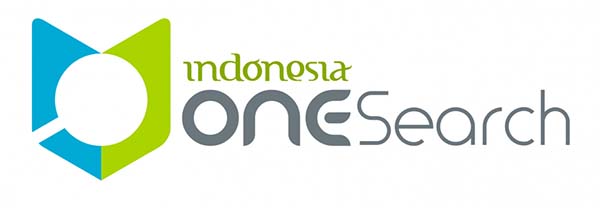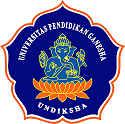Discrepancy Analysis of Authentic Assessment Implementation in EFL Classroom Based on Curriculum 2013 in SMAN 1 Kuta
Abstract
Penelitian ini bertujuan untuk menganalisis kesenjangan antara standar dengan kesenjangan implementasi nyata Penilaian Otentik di SMAN 1 Kuta. Ada dua pertanyaan yang menjadi pedoman dari penelitian ini: a) sejauh mana kesenjangan yang terjadi antara penerapan penilaian otentik yang ideal berdasarkan Kurikulum 2013 dengan penerapannya di kelas EFL SMAN 1 Kuta; b) persepsi para guru EFL mengenai penilaian autentik berdasarkan Kurikulum 2013. Penelitian yang digunakan adalah Model evaluasi kesenjangan oleh Provus (1971) di mana langkah-langkahnya terdiri dari 1) Tahap Definisi; 2) Tahap Instalasi; 3) Tahap Proses; 4) Tahap Produk dan 5) Tahap manfaat-biaya. Data dikumpulkan melalui wawancara dengan guru, kuesioner dan observasi kelas langsung menggunakan lembar observasi dari empat instrumen (Self Assessment, Penilaian Kinerja, Penilaian Proyek dan Penilaian Portofolio). Data yang diperoleh dianalisis dengan menggunakan statistik analisis deskriptif dengan menggunakan Pedoman Acuan Ideal Teoritis. Penelitian ini menemukan bahwa pada tahap perencanaan, kesenjangannya sangat rendah (34,25%);pada tahap pelaksanaan, kesenjangannya adalah (51,14%); pada tahap analisis dan pelaporan, kesenjangannya adalah sedang (46,11%). Dapat disimpulkan secara umum bahwa kesenjangan pada pelaksanaan penilaian otentik di EFL kelas di SMAN 1 Kuta adalah dengan kategori sedang (43,28%). Sementara itu kesenjangan dalam persepsi guru adalah sangat rendah (16,17%). Temuan ini menunjukkan bahwa guru memiliki pengetahuan yang baik dalam Kurikulum 2013 terutama pada penilaian otentik tetapi mereka masih menghadapi masalah dalam pelaksanaannya.
Kata Kunci : Kesenjangan, Kurikulum 2013, Penilaian Authentic, Persepsi Guru EFL.
This study aimed at analyzing discrepancy between the standard and the real implementation of Authentic Assessment in SMAN 1 Kuta. There are two research questions become guidelines of this study: a) the extent of the discrepancy between the ideal authentic assessment implementation based on Curriculum 2013 and the practice in EFL classrooms at SMAN 1Kuta; b) the EFL teachers’ belief on the authentic assessment based on Curriculum 2013. The research employed Discrepancy Evaluation Model by Provus (1971) in which the step comprises 1) Definition stage; 2) Installation stage; 3) Process stage; 4) Product stage and 5) Cost-benefit stage. The data were collected through interview with teachers, questionnaire and direct class observation using observation sheets of four instruments (Self Assessment, Performance Assessment, Project Assessment and Portfolio Assessment). The obtained data were analyzed using statistics descriptive analysis of Ideal Theoretical Reference. The research found that in planning stage, the discrepancy was very low (34.25%); in executing stage, the discrepancy was (51.14%);in analyzing and reporting stage, the discrepancy was moderate (46.11%). In general it can be concluded that the discrepancy in the implementation of authentic assessment in EFL classroom at SMAN 1 Kuta was categorized as moderate (43.28%). Meanwhile the discrepancy in teachers’ belief was very low (16.17%). These findings indicate that teachers have good knowledge in Curriculum 2013 mainly on Authentic assessment but they still faced problems in its implementation.
keyword : Authentic Assessment, Curriculum 2013, Discrepancy, EFL Teachers’ belief
Kata Kunci : Kesenjangan, Kurikulum 2013, Penilaian Authentic, Persepsi Guru EFL.
This study aimed at analyzing discrepancy between the standard and the real implementation of Authentic Assessment in SMAN 1 Kuta. There are two research questions become guidelines of this study: a) the extent of the discrepancy between the ideal authentic assessment implementation based on Curriculum 2013 and the practice in EFL classrooms at SMAN 1Kuta; b) the EFL teachers’ belief on the authentic assessment based on Curriculum 2013. The research employed Discrepancy Evaluation Model by Provus (1971) in which the step comprises 1) Definition stage; 2) Installation stage; 3) Process stage; 4) Product stage and 5) Cost-benefit stage. The data were collected through interview with teachers, questionnaire and direct class observation using observation sheets of four instruments (Self Assessment, Performance Assessment, Project Assessment and Portfolio Assessment). The obtained data were analyzed using statistics descriptive analysis of Ideal Theoretical Reference. The research found that in planning stage, the discrepancy was very low (34.25%); in executing stage, the discrepancy was (51.14%);in analyzing and reporting stage, the discrepancy was moderate (46.11%). In general it can be concluded that the discrepancy in the implementation of authentic assessment in EFL classroom at SMAN 1 Kuta was categorized as moderate (43.28%). Meanwhile the discrepancy in teachers’ belief was very low (16.17%). These findings indicate that teachers have good knowledge in Curriculum 2013 mainly on Authentic assessment but they still faced problems in its implementation.
keyword : Authentic Assessment, Curriculum 2013, Discrepancy, EFL Teachers’ belief
DOI: https://doi.org/10.23887/jpbi.v5i3.2522
Refbacks
- There are currently no refbacks.
Jurnal ini diterbitkan oleh :
Universitas Pendidikan Ganesha
Jurnal Pendidikan Bahasa Inggris Indonesia is licensed under a Creative Commons Attribution-ShareAlike 4.0 International License.
Jurnal Pendidikan Bahasa Inggris Indonesia indexed by:




Jurnal Pendidikan Bahasa Inggris Indonesia is licensed under a Creative Commons Attribution-ShareAlike 4.0 International License.




